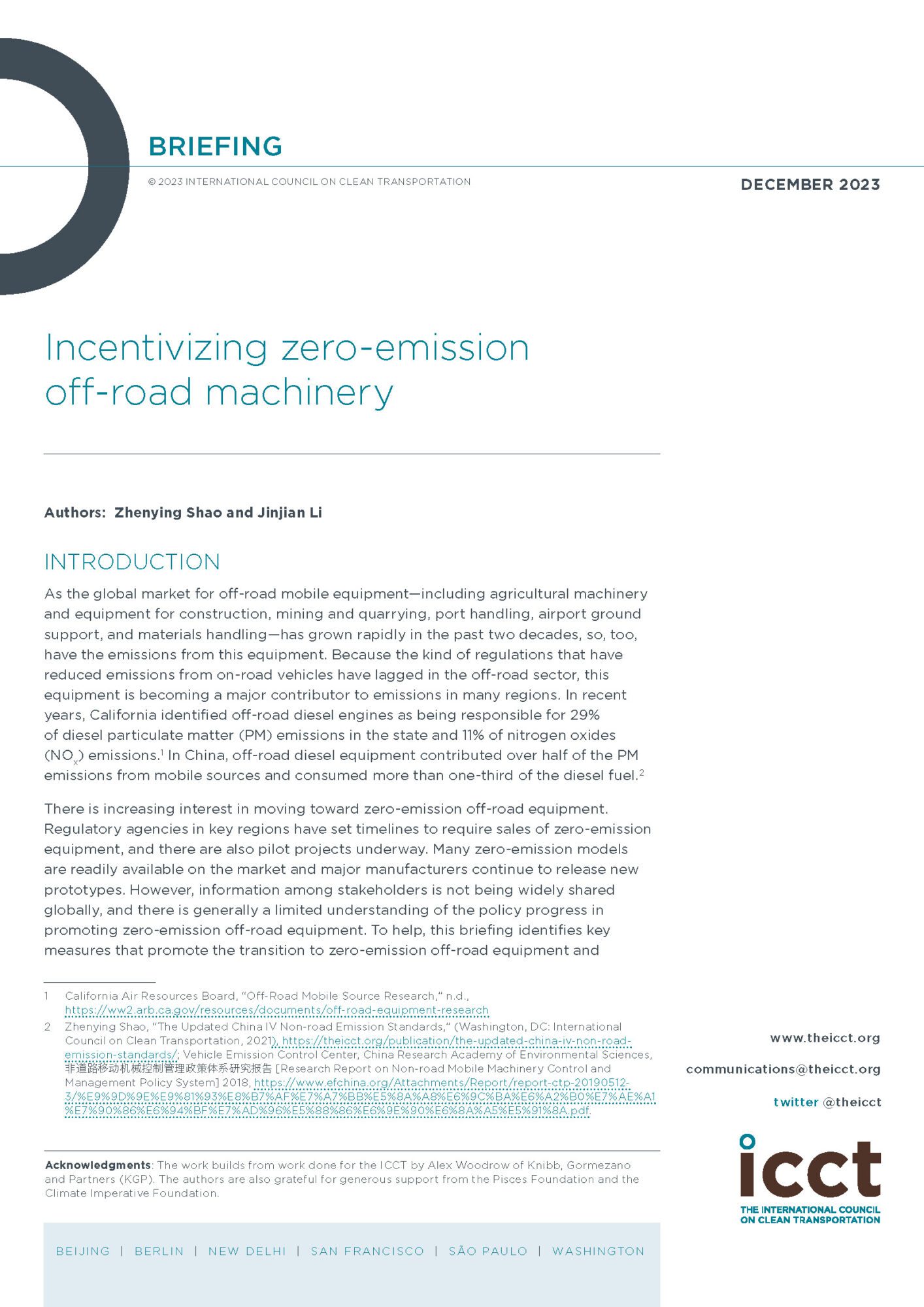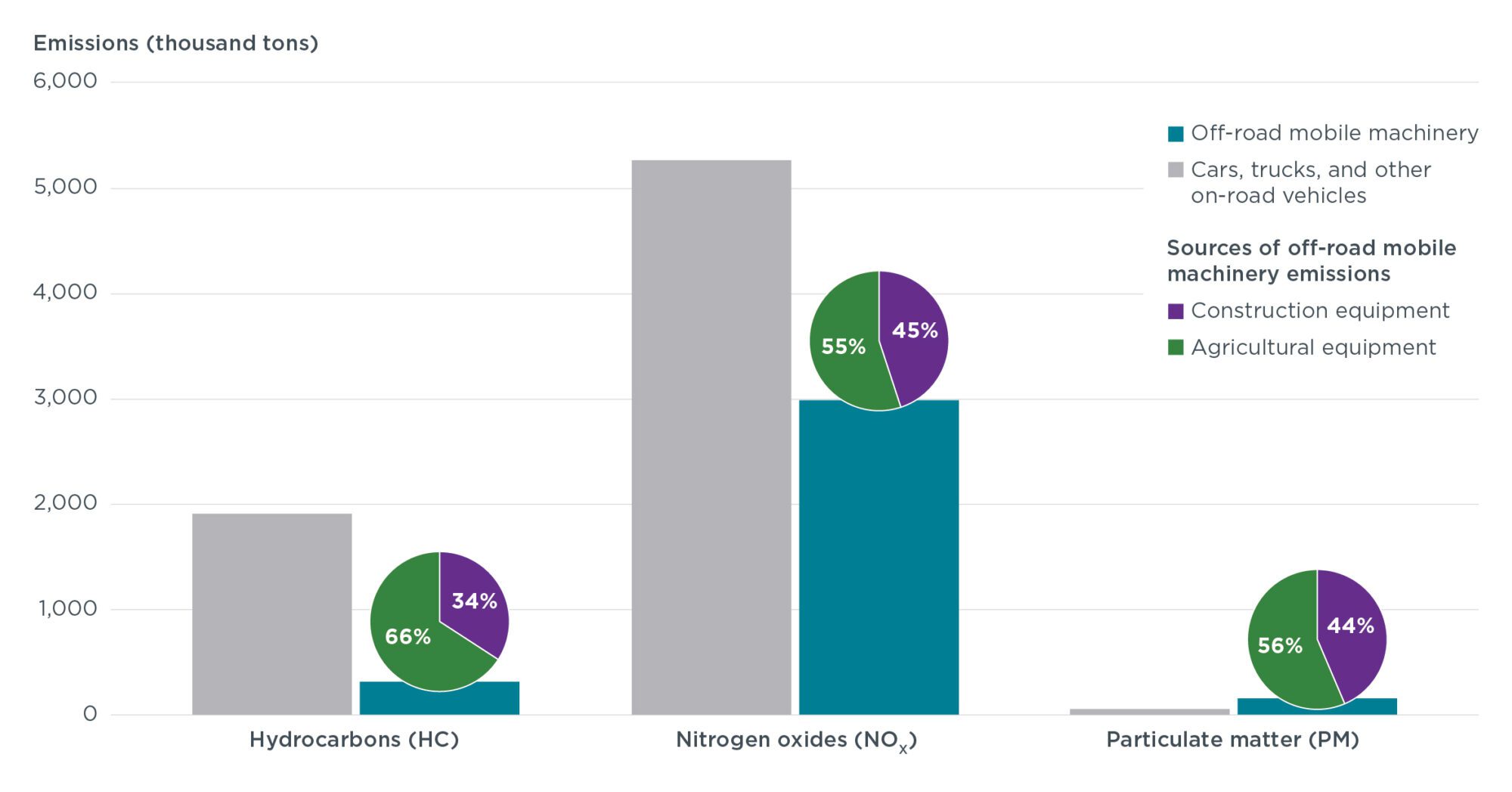Blog
Proactive policies by China to better support the transition to zero-emission construction equipment
The recently released China Mobile Source Environmental Management Annual Report 2023 from the Ministry of Ecology and Environment (MEE) shined a light on the significant emissions that come from the off-road sector, particularly construction equipment. Even though the industry is currently buzzing with positive signals of a promising future for zero-emission machinery, more could be done to speed the transition. Additional proactive policy measures—including pilot projects, greenhouse gas (GHG) emission standards, and ambitious zero-emission sales targets—would help propel China’s construction sector down the zero-emission path.
Let’s start with the good news. According to the MEE’s environmental information disclosure, 14 Chinese manufacturers voluntarily reported that they built 23 models of electric off-road mobile equipment between June 2022 and December 2023. These include a variety of construction machines such as loaders, dump trucks, reach stackers, excavators, and cranes used in a variety of applications, with rated weights ranging from under 10 tons to over 200 tons. Furthermore, Chinese manufacturers have several emerging zero-emission construction equipment models in the trial and demonstration stages; these are expected to hit the domestic and global markets soon.
The not-so-good news is that there are still no requirements for fuel use or for reducing carbon emissions from off-road equipment in China. Most of the construction machinery in the country is powered by diesel, and it consumes 9 million tons of fuel or more annually. The carbon dioxide (CO2) emissions from this sector are significant.
Other types of emissions are also of concern. Construction equipment in China totals fewer than 10 million units—mainly loaders, excavators, forklifts, rollers, and bulldozers. Based on data in the 2023 MEE report, we calculated that these machines emitted 1.3 million tons of nitrogen oxides (NOx) and 71,000 tons of particulate matter (PM) in 2022. That same year, the approximately 417 million cars, trucks, and other on-road motor vehicles in China emitted about 5.3 million tons of NOx and 53,000 tons of PM (Figure 1). A large portion of construction equipment is operated in densely populated urban areas, where the pollutant emissions generated have negatively impacted public health by contributing to poor air quality.
Figure 1. Emissions from motor vehicles and off-road mobile machinery in China in 2022
China has already taken some measures to reduce emissions from off-road equipment. Stage IV off-road tailpipe emission standards were implemented in December 2022. These standards require the adoption of diesel particulate filters, while in-use compliance is enhanced by requiring portable emissions measurement system testing and GPS remote monitoring systems. Additionally, the MEE recently released technical guidelines and specifications detailing the surveillance of off-road mobile sources and remote supervision of their environmental performance; these will be effective from July 2024 onward.
Another critical measure is the implementation of low-emission zones for construction equipment. Empowered by China’s Clean Air Law, local governments started designing and implementing low-emission zones to restrict the use of old, high-emitting construction equipment in 2016. Today, more than 300 cities in China have implemented such zones, and only equipment meeting minimum emission standards (usually China III or China IV) or zero-emission equipment is allowed.
Other governments around the world have taken even more action. For example, some pioneers are including GHGs in emission standards for construction machinery. California is considering GHG emission standards as part of its rulemaking process on more stringent Tier 5 standards for off-road diesel engines. The standards might include limits on CO2, methane (CH4), and nitrous oxide (N2O). The state also set ambitious goals to transition its entire in-use off-road fleet to zero-emission, “where feasible,” by 2035 and will phase out diesel-fueled fleets over 20 years old as early as 2028. Additionally, there is a proposal to introduce a requirement for zero-emission forklift sales starting in 2026. Incentive programs like the Clean Off-Road Equipment (CORE) Voucher Incentive program provide financial support for the adoption of zero-emission equipment by offering a subsidy of up to $500,000. California is also considering proposing zero-emission sales requirements for manufacturers that sell new off-road equipment in the state. China could consider all of this, as well.
Many European cities are taking action by announcing timelines for banning fossil fuels and phasing in zero-emission zones for construction equipment. Copenhagen, Denmark, successfully inaugurated its first zero-emission construction site in August 2020. Led by Oslo, six cities in Norway have initiated a gradual ban on fossil-powered off-road equipment since 2021, with the goal of using zero-emission machinery in all construction activities by 2030. Stockholm, Sweden, aims to phase out fossil fuel completely for construction by 2040. The cities of Helsinki, Espoo, Turku, and Vantaa in Finland plan to achieve fossil-fuel-free status at work sites by 2025 and also power at least 50% of the machinery and transport operations at the work sites with electricity, biogas, or hydrogen by 2030. London, United Kingdom—the first city in the world to establish a low-emission zone for off-road equipment in 2015—will progressively tighten the requirements over time. London is slated to become a full zero-emission zone by 2040.
Governments can be confident in setting strong policies that spur the development of the market for zero-emission off-road equipment. Research in California found that electric construction equipment such as excavators, graders, rubber-tired loaders, and tractors/loaders/backhoes could be powered to a significant extent using battery-electric powertrains. Publicly available databases in Europe and California showcase a wide range of electric and/or fuel cell models available in the market or in various stages of research, development, and demonstration. These databases can facilitate adoption by simplifying the search process for those in need of zero-emission machinery. The Advanced Clean Off-Road Equipment List Fact Sheet compiled by the California Air Resources Board has recorded approximately 390 electric construction equipment models since 2020. China stands out on the list with over 60 models.
There’s more. Research has shown that electric types of machinery have a 50% longer lifetime than their diesel counterparts and also reduce operational costs because electricity is relatively cheaper than diesel fuel, especially during off-peak hours. Shifting away from fossil fuel reliance would help reduce the need for oil imports in China and improve energy security. In addition, the total cost of ownership of electric equipment is projected to become comparable with diesel in the coming years as battery prices drop. For example, an analysis of agricultural tractors in India revealed a less than 5% cost difference between electric and diesel tractors over a 10-year ownership period, even when electricity costs and opportunity costs were assumed to be in the upper range.
Exchanges among stakeholders, including the first international symposium on zero-emission off-road equipment, which was co-organized by the ICCT, have fostered meaningful discussions that highlighted market readiness. Such events help to expedite the transition to zero-emission construction equipment in China. As a first step, China can consider a pilot zero-emission construction project in leading cities, supported by a comprehensive database of existing qualified machinery models. Incorporating GHG standards in the next rulemaking stage and setting ambitious zero-emission sales targets could be vital for driving industry-wide transformation. By taking such proactive measures, China can seize the historic opportunity to become a trailblazer in the construction sector and shape a greener tomorrow for off-road transportation.
Authors
Related Publications

INCENTIVIZING ZERO-EMISSION OFF-ROAD MACHINERY
This briefing paper identifies and discusses 12 key measures adopted worldwide that could incentivize the transition to zero-emission off-road equipment.



